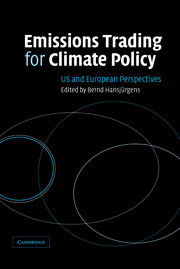Book contents
- Frontmatter
- Contents
- List of figures
- List of tables
- List of contributors
- Preface
- List of abbreviations
- 1 Introduction
- Part 1 Regulatory instruments for climate policy: theoretical aspects
- Part 2 The US approach to pollution control: lessons for climate policy
- 5 Implications of the US experience with market-based environment strategies for future climate policy
- 6 US experience with emissions trading: lessons for CO2 emissions trading
- 7 Climate change policy viewed from the USA and the role of intensity targets
- 8 Design issues of a domestic carbon emissions trading system in the USA
- Part 3 European policies to control greenhouse gases: the EU directive on emissions trading
- 14 Concluding observations
- Index
- References
6 - US experience with emissions trading: lessons for CO2 emissions trading
Published online by Cambridge University Press: 22 September 2009
- Frontmatter
- Contents
- List of figures
- List of tables
- List of contributors
- Preface
- List of abbreviations
- 1 Introduction
- Part 1 Regulatory instruments for climate policy: theoretical aspects
- Part 2 The US approach to pollution control: lessons for climate policy
- 5 Implications of the US experience with market-based environment strategies for future climate policy
- 6 US experience with emissions trading: lessons for CO2 emissions trading
- 7 Climate change policy viewed from the USA and the role of intensity targets
- 8 Design issues of a domestic carbon emissions trading system in the USA
- Part 3 European policies to control greenhouse gases: the EU directive on emissions trading
- 14 Concluding observations
- Index
- References
Summary
The experience with emissions trading in the United States over the past twenty-five years provides the material for drawing five lessons in this chapter for the use of this market-based instrument in controlling greenhouse gas (GHG) emissions. The first two lessons concern how well emissions trading has worked as a regulatory instrument and what makes it work. The other three lessons concern features that are important for GHG emissions trading, namely, temporal flexibility, voluntary participation, and the allocation of allowances.
Lesson 1: Emissions trading works
The main lesson from the US experience with emissions trading is that it works. This conclusion stands in clear contrast to the interim verdict drawn from the research associated with Robert Hahn in the mid and late 1980s (Hahn, 1989, Hahn and Hester, 1989a, 1989b) that emissions trading, although theoretically attractive, didn't seem to work in practice.
Hahn coined a wonderful metaphor to explain the disparity between theory and practice as observed in the early attempts by the EPA to introduce flexibility into the implementation of the Clean Air Act: the patient wasn't following the doctor's prescription. This assessment was not only blunt, but also hopeful in predicting improvement if the patient would only take the medicine (Hahn, 1989). The prediction would be substantiated in the decade of the 1990s and in particular by the “grand policy experiment” (Stavins, 1998) with SO2 emissions trading in the Acid Rain Program.
- Type
- Chapter
- Information
- Emissions Trading for Climate PolicyUS and European Perspectives, pp. 78 - 95Publisher: Cambridge University PressPrint publication year: 2005
References
- 17
- Cited by



